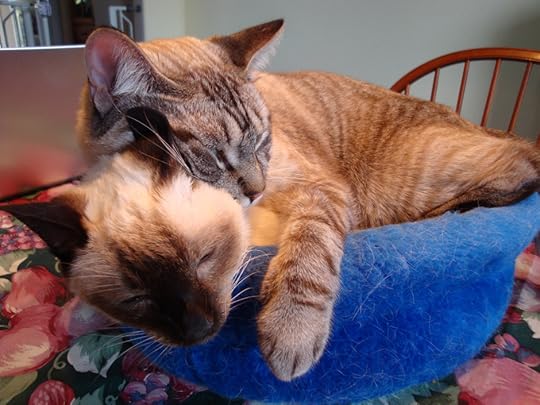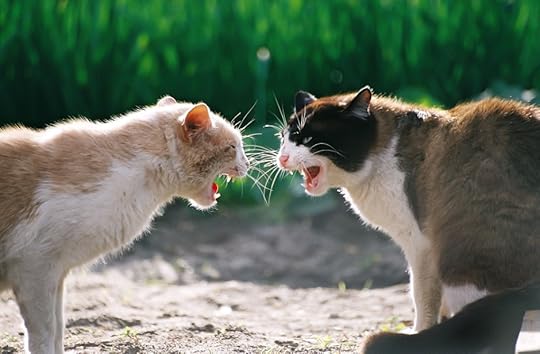Cat Fight! What to Do
Karma-Kat and Seren-Kitty engage in what appears to be a cat fight on almost a daily basis. From Karma’s standpoint, he wants to wrestle and play. Seren is not amused, and starts yowling at him to “back off, buster!” at the first hint he’s strolling her direction. Here’s the deal, though…no fur flies, nobody is injured, and Seren always comes back for more.
Thank cod! 
 Cats usually work out their social standing with posturing and kitty bluffs, and neither kitty gets hurt. However, the lowest ranking cat (often an older, or ill kitty like Seren) can become a target picked on by the other felines. Acting like a victim (slinking around, using submissive body language, hiding) is the equivalent of wearing a “kick me” sign and invites bullies to increase their bluster. Karma weighs more than twice as much as Seren’s 6-lb frame, and at 19 years old, my little Siamese wannabe has become quite frail. So these days, Karma spends time with Magic in my office while I work, and Seren gets some much appreciated alone time.
Cats usually work out their social standing with posturing and kitty bluffs, and neither kitty gets hurt. However, the lowest ranking cat (often an older, or ill kitty like Seren) can become a target picked on by the other felines. Acting like a victim (slinking around, using submissive body language, hiding) is the equivalent of wearing a “kick me” sign and invites bullies to increase their bluster. Karma weighs more than twice as much as Seren’s 6-lb frame, and at 19 years old, my little Siamese wannabe has become quite frail. So these days, Karma spends time with Magic in my office while I work, and Seren gets some much appreciated alone time.
 Cat-on-cat fights can result from any other kind, such as redirected aggression, play aggression, and fear aggression. Most intercat aggression involves intact same-gender cats, and gets worse during mating season. That’s why spaying or neutering before a year old decreases or prevents about 90 percent of intercat aggression.
Cat-on-cat fights can result from any other kind, such as redirected aggression, play aggression, and fear aggression. Most intercat aggression involves intact same-gender cats, and gets worse during mating season. That’s why spaying or neutering before a year old decreases or prevents about 90 percent of intercat aggression.
WHY CATS FIGHT
The top reason for cat fights is improper introductions. It’s a cat “rule” that a strange cat should be kicked out of the territory, so just dumping the newbie in with your crew asks for trouble. Once cats experience an altercation, that can predispose them to future fights because the experience was so unpleasant, scary, painful, etc. Think of it this way: the more cats “practice” being aggressive, the more likely they are to simply trigger into a fight at each others’ presence.
Sometimes cats get along fine, until suddenly they don’t. That leaves us wondering, what happened? Often this is because cats reach social maturity at two to four years of age when many cats first challenge others for status.
Changes to the cat’s social group (new cat arrives or familiar cat dies/leaves) can prompt an increase in face-offs. Environmental changes such as moving or rearranging cat furniture or feeding/bathroom stations, also can cause the fur to fly. Basically, any change in the routine may leave one or more cats so stressed they take it out on each other.
Not enough space predisposes cats to territorial disputes. Cats mark property with cheek rubs, patrolling, and urine marking. Some diabolical felines lure others into their territory and then “discipline” the other cat for trespassing. Feline territorial aggression is notoriously hard to correct, and marking behavior is a hallmark of potential aggression. Outdoor cats are more aggressive on their home turf and the cat closest to home usually wins the dispute.
SIGNS OF CAT AGGRESSION
It’s not all about hissing, screaming and wrestling. Cats use lots of subtle behaviors to control space. I call it “kitty poker” and in the best of all possible worlds, one cat backs down without a fight, and life goes on. Because it’s so subtle, though, you may not recognize power plays until one cat’s had enough and launches into a full-on cat fight.
Cats use verbal and silent communication to elevate their status in the eyes of the other felines. They challenge each other with stares, forward-facing body position, hisses and growls, mounting behavior and nape bites, or blocking access to food, play, or attention. Some dominant cats use “power grooming” behavior—energetically licking the other cat—to make her move away.
 Karma simply lies down on top of Seren, sort of a Sumo-Kitty move that makes her crazy and prompts her to give up her preferred bed. Yes, Karma’s a bit of a bully.
Karma simply lies down on top of Seren, sort of a Sumo-Kitty move that makes her crazy and prompts her to give up her preferred bed. Yes, Karma’s a bit of a bully.
Never allow cats to “fight it out” as that rarely settles conflicts but makes matters worse. Manage with behavior modification, counter-conditioning, and sometimes drug therapy. The 10 tips below can help ease the strain and in some instances resolve intercat aggression.
10 TIPS TO PREVENT CAT FIGHTS
Reduce the urge to fight by adding more territorial space so the cats don’t have to share climbing, hiding, and perching areas. Create a house of plenty with MORE toys, cat trees, litter boxes and feeding stations than the cats can use all at once.
Electronic cat doors that can only be opened by the collared victim cat will allow her to access the entire home yet retreat to a safe area the aggressor can’t follow. These pet doors open in response to the magnetic “key” inside the collar. Look for “keyed” pet doors at pet products stores or on the Internet.
Avoid rewarding poor behavior. For instance, giving food or attention to the aggressive cat may calm the angst but actually pays her to be a bully. Instead, catch Sheba before she gets hissy and redirect her behavior with an interactive toy, such as a flashlight beam, to lure her into play in another direction. That can also help her associate good things with the other cat—rather than with being nasty.
If the toy doesn’t work, interrupt with an aerosol hiss. Then once the cat walks away and is calm, reinforce the desirable response—acting calm—by offering a treat, toy or attention.
Go back to basics and treat the aggressive cats as though introducing them for the first time. It’s best to give the victim cat the choice location of the house, and sequester the bully cat in the isolation room.
If you see no significant improvement within a week, talk with a veterinary behaviorist to see if drug therapy may be helpful. Drugs may help control the aggressive behavior in the bully cat, while decreasing the “kick me” defensive posturing and vocalizing of the threatened cat. Drugs aren’t a cure, but can be a tool that helps training work more effectively.
Once the signs of aggression, anxiety, and/or hyper-vigilance fade, begin to gradually expose the cats to each other in very controlled situations. Begin with the cats in carriers, or controlled with a harness and leash, at opposite ends of your largest room or longest hallway.
During each session feed cats tasty foods or engage in play. This helps both cats learn to associate each other with fun, positive rewards.
Interrupt unacceptable behavior (hisses, growls) with a squirt of compressed air or water gun, and toss small stinky treats to reinforce “good” (calm) behavior. Counter conditioning can take months and require much patience and time.
Once cats have learned to tolerate each other and are allowed to freely roam, create at least two feeding stations and two bathroom locations but the 1 1 rule is even better (one for each cat, plus one). Locate them so cats won’t be trapped or surprised when using either.
Thunder and fury with no blood spilled indicates they have excellent bite inhibition but few fights resulting in lots of damage indicate that at least one of the cats either has very poor inhibitions, or seriously wants to kill the other cat. Cats that hate each other and draw blood during fights have an extremely poor prognosis. When all tactics have failed to stop two indoor cats from fighting, then ultimately one cat may need to be placed in a new home or permanently segregated from the other in another part of the house. That’s NOT giving up—it’s making life better for the cats, and you.
Do your cats squabble? How do you manage the disputes?
I love hearing from you, so please share comments and questions. Do you have an ASK AMY question you’d like answered–click the banner, above. Be sure to visit my PetHealthyStore for paw-some products for your furry wonders! Stay up to date on all the latest just subscribe the blog, “like” me on Facebook,and get a FREE BOOK when you sign up for Pet Peeves newsletter. Want the insider info on the latest books and appearances? Join my team and get advance sneak peaks related to my THRILLERS WITH BITE!






